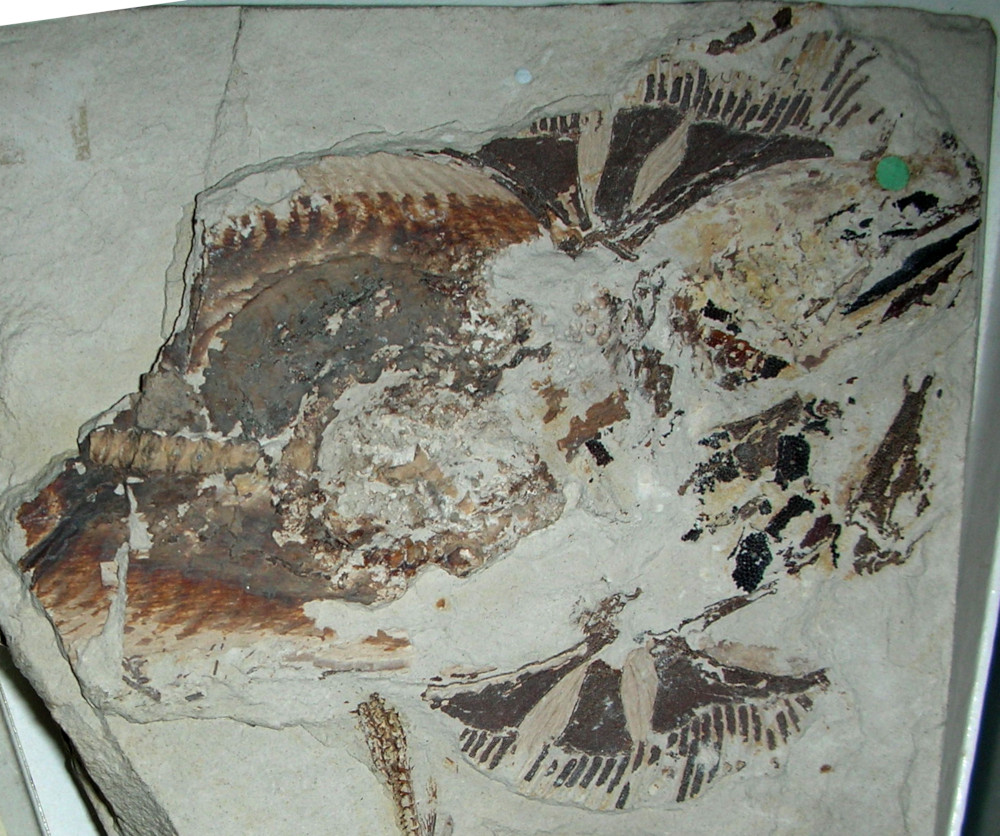Squatina crassidens
Woodward, 1889
Classification: Elasmobranchii Squatiniformes Squatinidae
Reference of the original description
Catalogue of the fossil fishes in the British Museum. Part. I. British Museum (Natural History): 474 p., fig., 17 pl.
Catalogue of the fossil fishes in the British Museum. Part. I. British Museum (Natural History): 474 p., fig., 17 pl.
Description:
Citation: Squatina crassidens Woodward, 1889: In: Database of fossil elasmobranch teeth www.shark-references.com, World Wide Web electronic publication, Version 01/2026
Please send your images of "Squatina crassidens" to info@shark-references.com

Squatina crassidens sp. nov.; imperfect skeleton, Senonian; Saliel Alma, Mt. Lebanon, basal cartilages of pectoral fin, [NHMUK PV 49547] © Charlie Underwood, Natural History Museum, London

Squatina crassidens sp. nov.; imperfect skeleton, Senonian; Saliel Alma, Mt. Lebanon, basal cartilages of pectoral fin, [NHMUK PV 49547] © Charlie Underwood, Natural History Museum, London
Description
Original description of Woodward, 1889 [2593]:
Type. A nearly complete fish, figured (one half nat. size) in Plate II. fig. 1. Head and branchial region short; the pectoral propterygium extending almost or quite as far forwards as the first branchial arch. The pectoral fins much elongated, with very long metapterygium. Pelvic fins also elongate, with at least twenty basal cartilaginous rays. Skin covered with numerous very minute prickles, but apparently without larger spinous tubercles; series of strong rounded dermal tubercles upon the anterior border of the head and each of the paired fins, and upon the lateral aspect of the tail. Teeth with very low crowns.
Form. ~ Loc. Upper Cretaceous (Turonian): Sahel Alma, Mount Lebanon, Syria.
P.4017. Type specimen, figured in Plate II. figs. 1, 4. Except the median fins, almost the whole of the fish is preserved, though in most parts munch defaced by crushing and extrication from the matrix. The total length of the fossil is 0•42 meter, and the maximum breadth between the outer margins of the pectoral fins would probably be about 0•25 meter. The vertebrae are of the usual type, and strong ribs occur posterior to the pelvic girdle. In the right pectoral fin the propterygium (pr.p) and mesopterygium (1111.p) are seen; and there are indications of a preaxial thickened ray in the pelvic fins. The teeth are well shown in a portion of the mouth, and are remarkable for the extreme lowness of the crown. An anterior view of one of these teeth, enlarged seven times, and an upper view, on the same scale, are given in fig. 4; there are radiating striations upon the posterior portion of the crown. The dermal tubercles are very minute, and are better shown in No. 48105 (fig. 5). There are also fossilized remains of the muscles, and a portion of those of the caudal region (mu) is so displaced as to have the false appearance of being a fin.
Original description of Woodward, 1889 [2593]:
Type. A nearly complete fish, figured (one half nat. size) in Plate II. fig. 1. Head and branchial region short; the pectoral propterygium extending almost or quite as far forwards as the first branchial arch. The pectoral fins much elongated, with very long metapterygium. Pelvic fins also elongate, with at least twenty basal cartilaginous rays. Skin covered with numerous very minute prickles, but apparently without larger spinous tubercles; series of strong rounded dermal tubercles upon the anterior border of the head and each of the paired fins, and upon the lateral aspect of the tail. Teeth with very low crowns.
Form. ~ Loc. Upper Cretaceous (Turonian): Sahel Alma, Mount Lebanon, Syria.
P.4017. Type specimen, figured in Plate II. figs. 1, 4. Except the median fins, almost the whole of the fish is preserved, though in most parts munch defaced by crushing and extrication from the matrix. The total length of the fossil is 0•42 meter, and the maximum breadth between the outer margins of the pectoral fins would probably be about 0•25 meter. The vertebrae are of the usual type, and strong ribs occur posterior to the pelvic girdle. In the right pectoral fin the propterygium (pr.p) and mesopterygium (1111.p) are seen; and there are indications of a preaxial thickened ray in the pelvic fins. The teeth are well shown in a portion of the mouth, and are remarkable for the extreme lowness of the crown. An anterior view of one of these teeth, enlarged seven times, and an upper view, on the same scale, are given in fig. 4; there are radiating striations upon the posterior portion of the crown. The dermal tubercles are very minute, and are better shown in No. 48105 (fig. 5). There are also fossilized remains of the muscles, and a portion of those of the caudal region (mu) is so displaced as to have the false appearance of being a fin.
Remarks
shark-references Species-ID=11475;
valid after Woodward (1889) p. 69 [2593];
synonym of Sclerorhynchus atavus after Woodward (1892) p. 534 [2597]; Cappetta (1980) p. 167 [327]; Underwood et al. (2016) [23106];
shark-references Species-ID=11475;
valid after Woodward (1889) p. 69 [2593];
synonym of Sclerorhynchus atavus after Woodward (1892) p. 534 [2597]; Cappetta (1980) p. 167 [327]; Underwood et al. (2016) [23106];
References

Catalogue of the fossil fishes in the British Museum. Part. I. British Museum (Natural History): 474 p., fig., 17 pl.

Catalogue of the fossil fishes in the British Museum. Part. I. British Museum (Natural History): 474 p., fig., 17 pl.


















